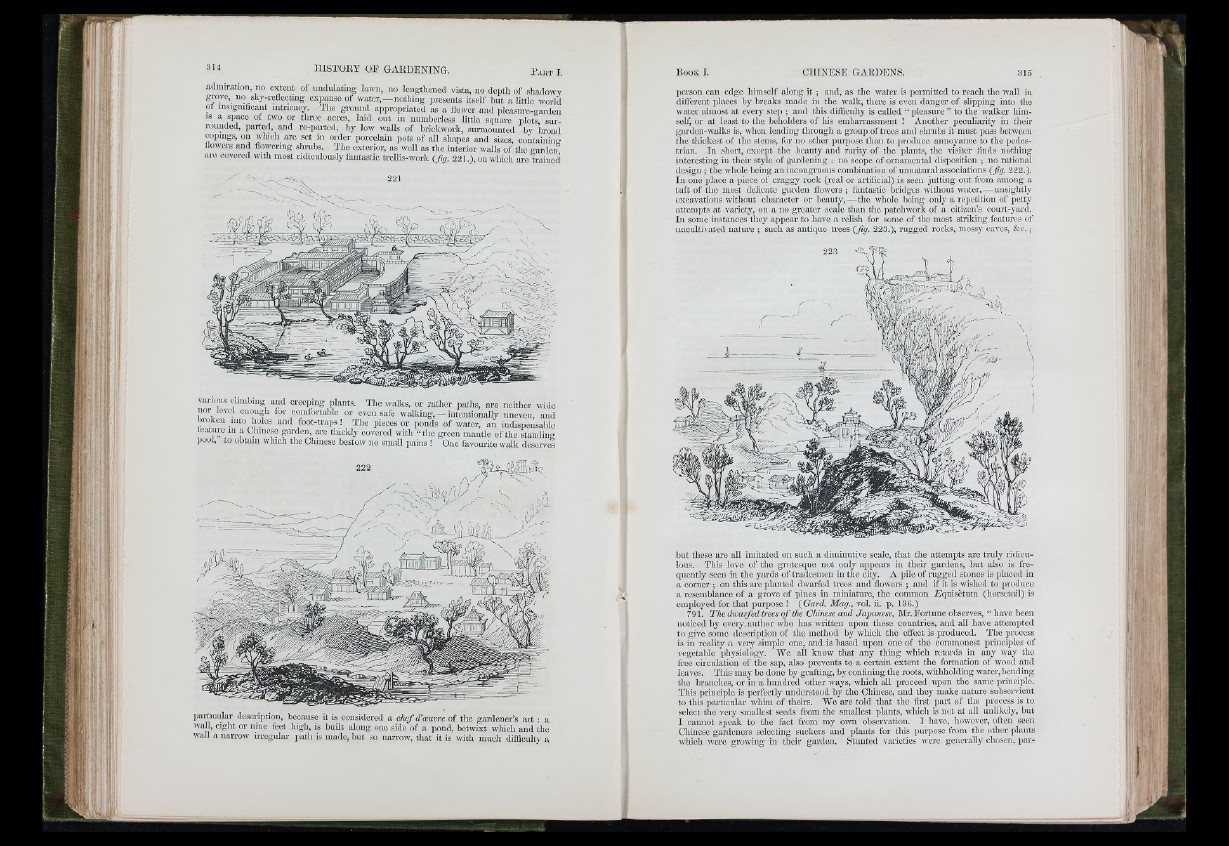
Ël l 'M i
1 ®
g)-.'
I- -!c‘>
- m
i T i ' i
A-icliniration, no extent of undulating lawn, no lengthened vísta, no depth of shadowy
grove,_ no sky-rcflcctmg expanse of water,— nothing presents itself but a littlo woild
ot insignificant intricacy. The ground appropriated as a fiowcr aud plcasurc-gardeii
IS a space of two or three acres, laid out in numberless little square plots, surrounded,
parted, and re-parted., by low walls of brickwork, surmounted by broad
copma's, on which ai*e set in ordor i-invDPln.in -nnfc/yf oii oU-aYa/a/- ....a .
various cHmbing and creeping plants. The walks, or rather paths, are neither wide
noi ic-vel enough for conifortable or even safe walking, — intentionally uneven, and
Oiokeii into holes and foot-traps ! Tho pieces or ponds of water, an indispensable
leaturc in a Chinese garden, are thickly covered with “ the green mantle of the standing
pool, to obtain wluch the Chinese bestow no small pains ! One favomitc walk deserves
\ é
I' r '"-vS ./ ■'
particular description, because it is considered a chef d’oeuvre of the gardener’s art : a
wall, eight or nine feet high, is built along one side of a pond, betwixt whicli and the
wall a narrow irrcgulai- path is made, but so narrow, that it is with much difficult\- a
person can edge himself along it ; and, as the water is permitted to reach tho wall iu
diflcrent places by breaks made in the walk, there is ci'cn danger of slipping into the
water almost at every step ; and this difficulty is called “ pleasure ” to the walker himself,
or at least to the beholders of his embaiTassment ! Another peculiarity in tlicir
garden-walks is, when leading through a group of trees and slirubs it must pass between
the thickest of the stems, for no other jmrpose than to produce annoyance to the pedestrian.
In short, except the beauty and rarity of the jilants, the visiter finds notliing
interesting in thcir style of gardening : no scope of ornamental disposition ; no rational
design ; the whole hcing an incongruous combination of unnatural associations (fig. 222.).
In one place a piece of craggy rock (real or artificial) is seen jutting out from among a
tuft of the most delicate garden flowers ; fantastic bridges without water,— unsightly
excavations without character or beauty,— the whole being only a repetition of petty
attempts at variety, on a no greater scale than the patchwork of a citizen’s court-yard.
In some instances they appear to have a relisli for some of the most strildng features of
uncultivated nature ; such as antique trees (fig. 223.), rugged rocks, mossy caves, &c .;
but these ai-e all imitated on such a diminutive scale, that the attempts are truly ridiculous.
This love of the grotesque not only appears in their gardens, but also is frequently
seen in the yards of tradesmen in the city. A pile of rugged stones is placed in
a corner ; on this ai'c planted dwarfed trees and flowers ; and if it is wished to produce
a resembiance of a grove of pines in miniature, the common £ quisetum (horsetail) is
employed for that purpose ! (Gard. Mag., vol. ii. p. 136.)
791. The dwarfed trees o f the Chinese and Japanese, Mi*. Fortune observes, “ have been
noticed by every, author who has wi'itten upon tliesc countries, and all have attempted
to give some description of the method by which the effect is produced. The process
is in reality a very simple one, and is based upon one of the commonest principles of
■vegetable ])hysiology. Wc all know that any thing which retards in any way the
free circnlatioii of the sap, also prevents to a certain extent the formation of wood and
leaves. This may be done by grafting, by confining the roots, withholding water, bending
the branches, or in a hundred other ways, whicli all proceed upon the same principle.
This principle is perfectly understood by the Chinese, and they make nature subseiwient
to this particular whim of theirs. We are told that the first part of the process is to
select the I’ciy smallest seeds from the smallest plants, which is not at all unlikely, but
I cannot speak to the fact from my own observation. 1 have, however, often seen
Chinese gai'dcncrs selecting suckers and plants for this purpose fi’om the otlicr plants
wliich ivcrc growing in thcir garden. Stunted varieties were generally chosen, par